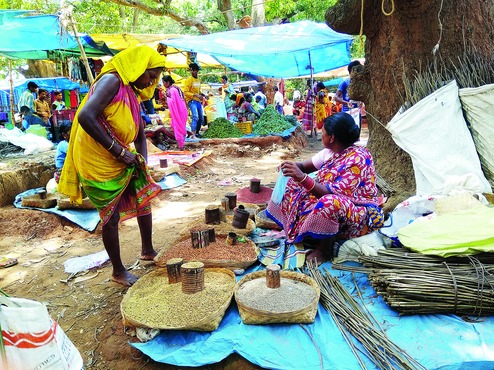
Koraput: Tribal researchers feel that local haats (weekly markets), which are the heart of village economy here, should be properly documented by officials concerned.
A visit to the district is not complete without a trip to such market places. These haats, which come up at intervals of seven days at particular places, offer a peak into the socio-economic life of the local residents.
" Haats in Koraput district are not merely a place of selling and purchasing commodities, but it provides a platform for the rural folks to communicate and share views, ideas and news of their respective villages. Villagers trek several kilometres to reach these haats. In this age of modern communication gadgets, these haats still hold their uniqueness as most of the remote areas, where they are held, are yet to covered under the telecommunication network," said Paresh Rath, a tribal researcher of Jeypore.
The products are earthy, endemic to rural living and consist of rice, mahua flowers, vegetables, tobacco, various forest produces, tribal ornaments, brooms prepared from wild grass and a few factory products.
"A haat is not a place of mere shopping or marketing. It provides scope for recreation and social interaction. Here, the tribal people exchange information about family, marriages and festivals. In short, it is a meeting place for exchanging news and views. Haats are the nerve centre of tribal life. You get the taste of the local flavour in these haats," said Prafulla Padhi an academic, who studies the tribal culture of Koraput.
Foreign tourists lap up the forest products and liquor. Tribal women in their traditional attire add colour to the gathering and the whole haat provides a festive look.
"Every Saturday, I come to the haat with my produce to sell them. It's not possible for small farmers like me to go to the urban areas to sell our products, so haat is the best option for us. Also, we could purchase things of our need at the haat," said Kamulu Saunta, a farmer selling vegetables at the Kumuliput haat.
The district hosts about 200 haats a week. While, Ramagiri and Boipariguda haats are famous for rare forest products, the haat of Onkadeli is a huge draw with foreign tourists as women from the primitive Bonda trible visit the haat. The Kunduli haat of Pottangi block is famous for its vegetable trading. On each Friday, traders from Andhra Pradesh and Chhattisgarh take truckloads of vegetables from the haat.
" Haat is such a place where you can get variety of things to buy, and, that too, on a cheaper rate. From vegetables, grocery, dress materials, household articles, shoes, watches to sweets and snacks - everything is on display at a haat," said Sanjay Pani, a buyer at Kumuliput haat.
The Jeypore haat, which comes up on every Tuesday, is famous for cattle trade. If you are a music lover, then the haat of Kakrigumma could be the ideal shopping spot for you as various traditional drums and other tribal musical instruments are found here in plenty. The markets combine a bit of entertainment with trading.
Delicacies such as mudhi, muan, chuda muan, gaja and gululla should not be given a miss for they are simply delicious, fresh and homemade.
"On a regular basis, works are carried out to strengthen the infrastructure at the haats. While these are equipped with drinking water facilities, the sellers are provided with permanent concrete verandahs to display their products among others. While few haats of the district has been documented, efforts are on to document all the identified haats of the district," said Koraput sub-collector Krutibas Rout.










